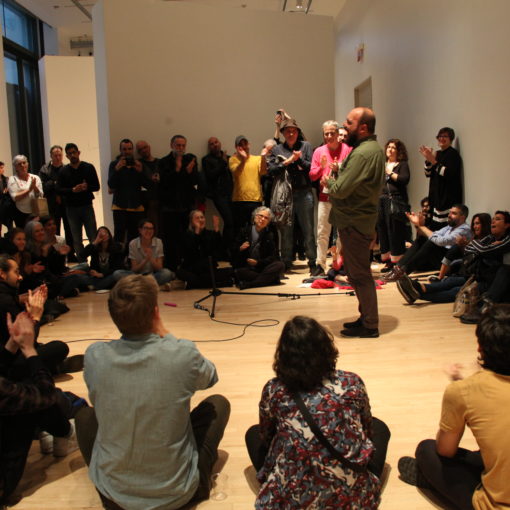
As a Mellon Fellow, I spent the fall semester working with Constructive, a nonprofit branding and web design agency, as their Communications Associate. My key responsibility in this role has been managing their communications: social media, newsletters, and thought leadership. As I worked to increase stakeholders’ engagement with Constructive, I picked up some handy tips on how to use social media to create an invested audience for one’s work.
For better or worse, social media has become a mainstay of our routines. Our reliance on Twitter, Instagram, Facebook and LinkedIn to foster a sense of connectedness has only intensified with the pandemic and its social distancing imperative. Considering how much time we spend gathering in these virtual spaces, it’s worthwhile to think seriously about how we can incorporate social media in our public humanities endeavors to reach wider audiences. Social media can serve as the main home for your project, as it has for my own (Academia for All—an Instagram-based project that distills complex academic texts into digestible bites that invite more expansive public engagement). It can also serve as a complement to a project that may live elsewhere.
Drawing on my own experience at Constructive and with Academia for All, I offer a few tips here to help you incorporate social media into your work in order to engage diverse publics in a more robust way.
Develop familiarity with different social media platforms
Imagine scrolling through LinkedIn to see pictures of someone fawning over their puppy. Or seeing someone’s professional history on Instagram. That’d feel a little weird, wouldn’t it?
Different social media platforms host specific kinds of content. Take some time to figure out what kind of content you’ll be sharing and accordingly determine which social media platform suits your needs. If you’re choosing Instagram, make sure to have a library of dynamic and high-quality images. LinkedIn is best suited to career-related material. Twitter allows more flexibility, but be mindful of its character limit; the content you draft should pack a punch.
You can also choose to have your work live on different social media platforms simultaneously, but avoid sharing the same content everywhere. A screenshot of your website may work for Instagram, but a longer think piece laying out its intricacies may garner more interest on LinkedIn.
Explicitly define your messaging goals, audience and tone
Write out your goals, and be as specific as you can. Why are you sharing what you’re sharing on social media? What do you hope to accomplish? These goals will help define both your messaging focus and the impact of your outreach. Do you want to elicit a specific community’s interest in your work or facilitate a conversation between groups? Perhaps you want to generate curiosity about your podcast or drive traffic to your website?
Closely intertwined with this task of defining messaging priorities is that of identifying your audience. Who are you creating content for? It’s often helpful to create defined audience personas – flesh out the different audience groups you imagine being on the other side of the screen. Is another researcher looking at your project? What do you think they’re drawn to? Or is it a community activist? What motivates them? What questions may they be asking about your work? Detailed audience personas helps you develop targeted content that speaks directly to the specific audiences you want to reach.
Engaging in the above activities will lay the groundwork for the next step of determining the tone of your communications. Again, define this as specifically as you can; it’s crucial for maintaining consistency across your posts. Do you want your posts to be light and playful, or formal and detached?
Create a content calendar
Once you have your target audiences on board for the ride, you don’t want to lose them. A surefire way to keep them hooked is to post regularly. It doesn’t have to be every day. Establish a cadence that makes sense for your particular project and stick to it. Hootsuite is a particularly nifty tool for this – it allows you to schedule posts, which it will then post on your behalf on the day and time you specify. Creating a content calendar is especially helpful for maintaining this regular rhythm. Plan out, a couple of weeks or even a month in advance, when and what you’re going to be posting. This is particularly useful if you’re posting across social media platforms rather than sticking to a single one.
Another strategy I’ve found to be helpful is to create a calendar of relevant events to peg posts to. For example, if your project seeks to engage Black communities, you definitely want to post relevant content during Black History Month. There are a host of similar events you can anticipate and plan for, so that you’re not scrambling for content or completely missing the occasion when it does roll around.
Track your performance
Without measuring how your content is performing, you won’t really know whether you’re achieving the goals you set out to accomplish. Most social media platforms provide basic insights into how your page is performing, but if you want to dig deeper, you can also sync your social media to a Google Analytics account. By doing this, you can find out more about the demographic features of those interacting with your content, how many of those visitors are then going on to visit your linked podcast/website, and so on. Sifting through this data can help you become more intentional with the kind of content you share going forward.
Social media and its algorithms are ethically complex, there’s no doubt about that, but there’s also no denying that these platforms facilitate communication with audiences dispersed across geographies and professional sectors. If we want to take work being done in the university beyond the confines of its walls, it’s worth exploring which channels help amplify our voices in the most effective ways.
 Queenie Sukhadia is a student in the English PhD program and Mellon Humanities Public Fellow. Her research is focused on questions of secondary witness—how we receive the narratives of those testifying to atrocities—in global human rights literature. She is interested in thinking through the ways in which we can read testimonial narratives outside of the frames made common-sense by liberal structures such as the courtroom. A firm believer in the idea that the university is only one of many valuable spaces of knowledge production, Queenie is committed to working at the intersection of academia and external publics to facilitate public good. Apart from being a scholar, she is also a creative writer and published a collection of short stories, A City of Sungazers, in 2017. Queenie holds a BA in English (with high honors) and Psychology from Dartmouth College and an MA in English (with distinction) from Georgetown University.
Queenie Sukhadia is a student in the English PhD program and Mellon Humanities Public Fellow. Her research is focused on questions of secondary witness—how we receive the narratives of those testifying to atrocities—in global human rights literature. She is interested in thinking through the ways in which we can read testimonial narratives outside of the frames made common-sense by liberal structures such as the courtroom. A firm believer in the idea that the university is only one of many valuable spaces of knowledge production, Queenie is committed to working at the intersection of academia and external publics to facilitate public good. Apart from being a scholar, she is also a creative writer and published a collection of short stories, A City of Sungazers, in 2017. Queenie holds a BA in English (with high honors) and Psychology from Dartmouth College and an MA in English (with distinction) from Georgetown University.







